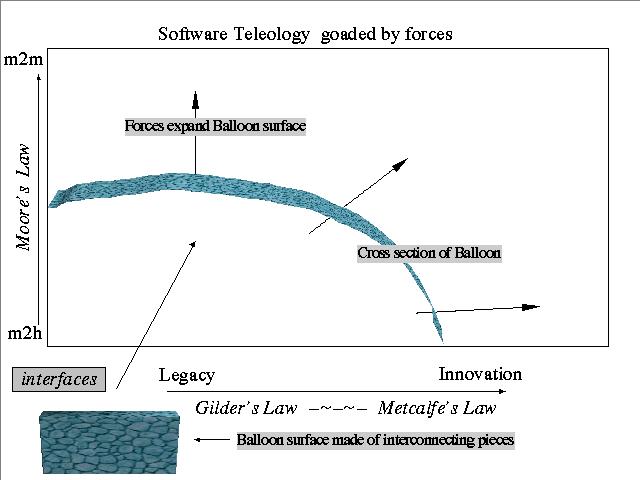Or is it really that simple?
We are constrained even as we are enabled by legacy infrastructure on
the one hand and Network Age opportunities on the other. As we approach
this idea of "purpose" in software design, examining both legacy and opportunity
will prove to be useful.
Goads
But first a discussion of "goads," if we can call them that. These
tendencies, which we deign to call laws in a descriptive sense, are the
meat of Opportunity's entree. Some of the driving forces that we acknowledge
in our industry are expressed by one of Sun Microsystems' themes:
the Net Effect.
The forces alluded to in the marketing guise of the "Net Effect"
are the exponential phenomena we characterize as Moore's Law, Metcalfe's
Law and Gilder's Law, to wit:
o Moore's Law: periodic (12-24 month) doubling of processor
speed
due to shrinking transistors.
o Gilder's Law: periodic (6-12 month) doubling of global
telecommunications bandwidth. (ave. Mb/n-s)
o Metcalfe's Law: the potential value of any network is the square
of the available nodes on the network. V = n^2
These three "laws" and the implications and corollaries to these
observations will help us to describe a "fitness landscape" in which the
software we create must "make a living." The external forces (called
"goads" below) that these laws represent will come into play from a
teleological perspective, as goads and drivers for software development.
(A goad is a sharp stick used for prodding animals - it also means a
stimulus, or stimulation to action).
Interfaces
The currency of software design is the rich set of legacy interfaces
we've accumulated over the decades. Now that XML has arrived
with the promise of self-describing data everywhere, legacy interfaces
become less problematic and more valuable, ensuring a high demand for legacy
data for years to come.
Recall Eric Raymond's metaphor of the software noosphere. Once a piece
of the noosphere has been successfully "homesteaded," whether via an
open-source project, or a large corporate development team, that nugget
of innovation has now become part of the legacy. Recall too Kaufman's
notion of the "adjacent possible." This can metaphorically describes the
innovation space nearest the legacy.
While "innovation" isn't exactly the flip-side of "legacy," for the
sake of this portrait we'll position them as such. From a software
development perspective, there are generally many legacy interface issues.
The extent to which legacy issues can be ignored is a measure of how much
innovation potential an unexplored section of the noosphere may offer.
If we imagine legacy software (interfaces) to be a series of interconnected
pieces, the interfaces form the surface of a growing balloon, as in Figure 1.
Legacy grows to consume Innovation over time as we imagine the
balloon growing outward.
An example of a high legacy dependency project might be a software endeavor
tasked with exposing existing automated internal business practices to
a down-stream vendor via a trusted, secure Internet server. This
sort of software development would need to pay particular attention to
existing interfaces, as the adaption and adoption of those interfaces to
broader network-service needs is the purpose of the project.
For an example of a project that is less dependent on legacy interfaces
and freer to explore innovation, at least in terms of software interfaces,
we might consider software for a new device which, while connected to the
network (and thus utilizing a vast legacy of interfaces), nevertheless
requires a class of service for which there are no existing APIs - say,
for instance, a generic heart monitor/pace-maker for humans with Internet-based
regular adjustments, alarms and possible services, ("And an ambulance shows
up before you even know you need it!") made available on a subscription
basis, despite the fact that standardized interfaces for wireless
cardio-telemetry are TBD.

Figure 1: The Legacy Balloon Grows Over time (Click image to enlarge).
On the Y axis, also growing in time, are machine-to-machine interfaces
and communications, beneath a legacy sphere of machine-to-human interfaces
and communications. Clearly growing legacy interfaces provide a growing
array of considerations for software developers. It is also important
to note other drivers and goads that move the legacy toward innovation.
This is where we layer in the goads described above.

